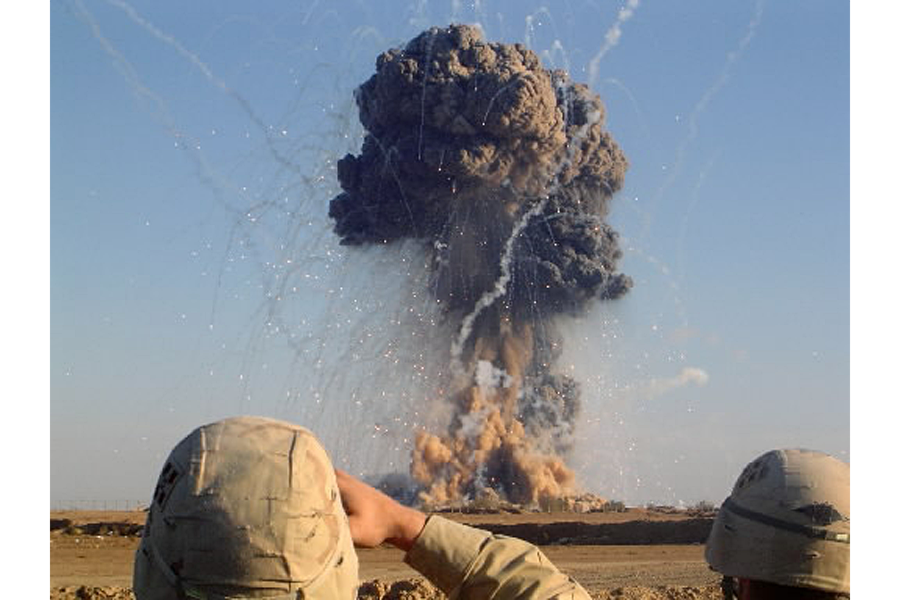When explosions rocked Baghdad in 2006, a seismometer was listening
Boom! Boom! Boom!
Explosions rocked Baghdad on Oct. 10, 2006 as mortar fire exploded on impact at a United States ammunition supply depot. The night was punctuated with Earth-shaking explosions, as the site was bombarded and the ammunition blew up in spectacular fireworks.
Buried in the ground just over four miles away, a seismometer quietly recorded every shake and quake through that fiery night.
When Ghassan I. Aleqabi, a seismic deployment coordinator at Washington University in St. Louis, realized that motion-measuring instrument was so close to the explosions, he wondered if the seismometer had picked it up. It had, and that was just the beginning.
Dr. Aleqabi's inquiry into the quakes and shakes of that "cook-off" led him to find a broader seismic record of fighting during the Iraq War in Baghdad. The connections he found are reported in a paper published Tuesday in the Bulletin of the Seismological Society of America.
And researchers are hoping that such studies of seismic records may prove helpful in both detecting and responding to various kinds of violent detonations.
While the seismometer was installed and recording in 2005 and 2006, the instrument recorded the shock waves of mortar fire, car bombs and other explosions, even though the shakes were significantly smaller than those of earthquakes.
"These seismometers are like ears and they hear every sound that either the Earth makes or humans make," one of the paper's authors, Washington University seismologist Michael Wysession, tells The Christian Science Monitor in an interview.
The researchers compared their seismic data to news, military and other reports of explosions nearby the seismometer installed in Baghdad to confirm their findings. They found that the seismometer not only picked up such explosions in the area, but different types of explosions had different seismic signatures.
"The mortar blast has a very particular signature," Dr. Wysession says. "The mortar explosion has a very particular mix of frequencies because you have a metal case that splinters and shatters when an explosion occurs and this gives you a different sound quality."
But identifying the signature isn't always straightforward.
Aleqabi, the lead author of the paper, found data for the explosion of two different car bombs, but their seismic signatures looked remarkably different. After learning more about the explosions, he realized that the environment had left its mark.
One of the bombs had detonated in a relatively open space while the other exploded on a more urban street, surrounded by tall buildings. That explosion would have echoed off the buildings, meaning a more complex set of data made it to the seismometer.
"Seismometers were originally designed to look at earthquakes," Wysession says. But "to use seismometers in military operations is nothing new."
In fact, the seismometer that picked up these explosions in Baghdad was there for another purpose too. That instrument was part of an array across Iraq set up to determine the seismic properties of the continental crust, according to Wysession. That knowledge would help the US military determine how best to monitor seismic signals in the region in order to detect if a nuclear bomb was tested by any of Iraq's neighbors, namely Iran, Wysession says.
Won-Young Kim, a research at the Lamont-Doherty Earth Observatory of Columbia University who was not involved in the paper, explains, "Underground nuclear tests are usually observed by the seismic signals from the tests, because above ground nuclear tests are banned and would be detected by many devices including orbiting surveillance satellites," in an email to the Monitor.
Dr. Kim, who works on such nuclear-monitoring seismometers, says the researchers' findings are "not surprising." He points out that seismic signals from rock quarry blasts and military practice exercises are commonly felt, and heard, in the US.
"However, it is unusual to have seismic observation from the military operations in urban terrain – which require seismic station located close to the battle ground," Kim says.
And that urban setting may be increasingly relevant for monitoring violence today.
Wysession says, "Warfare is occurring on a small-scale often in urban settings." He cites terrorist attacks like those in Paris in November.
Seismometers coupled with infrasound devices can pick up sound waves that could help officials pinpoint the sequence of events in such violent occurrences in a way that eyewitness accounts and satellites might not be able to, Wysession says. Scientists call such use of the devices "forensic seismology."
The explosions in Baghdad aren't the first violent events to be picked up by seismometers.
"There are many occasions, when seismometers provided information from incidents," Kim says. Kim himself identified seismic signatures from the collapse of the World Trade Center in New York City on Sept. 11, 2001. "Seismic stations provided accurate timing of building impacted by airplane and subsequent collapse," he says.
Looking at those vibrations helped scientists understand how and why the twin towers crumbled.
Not only can seismometers help determine the sequence of events in such an Earth-shaking scenario, Wysession suggests they can also help initiate a real-time response.
"If we had a network [of devices], we could've pinpointed where those mortars were being fired from" during the "cook-off," he says. "If we had someone looking at that in real time, they might have reached that spot and caught the attackers before there was the straw that broke the camel's back and set the depot on fire."







